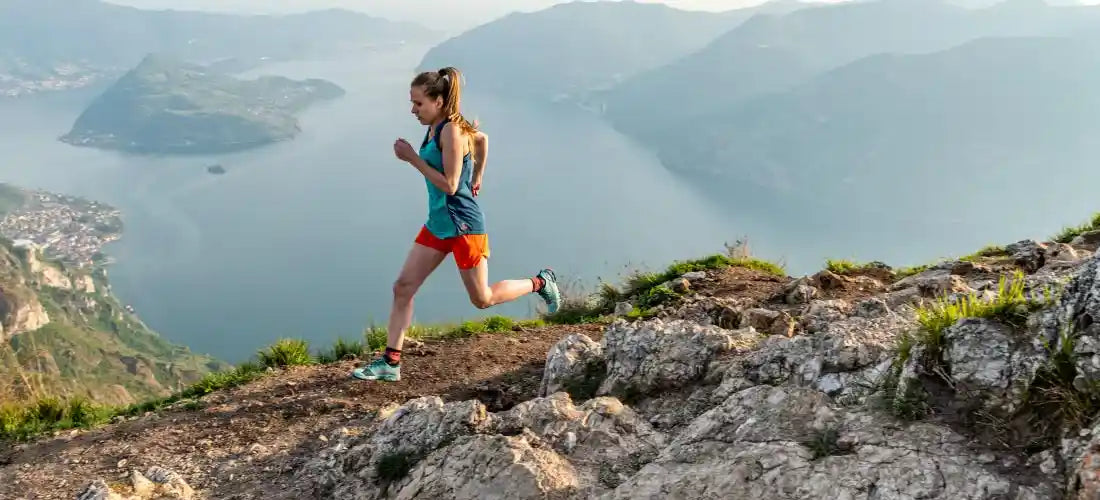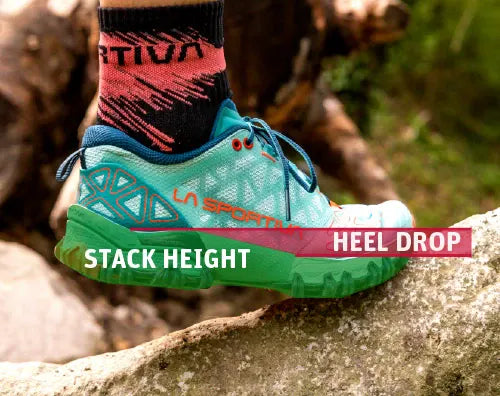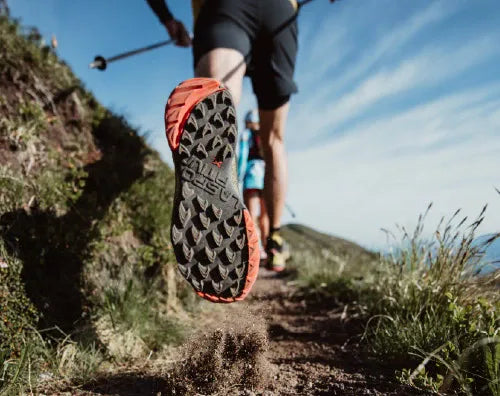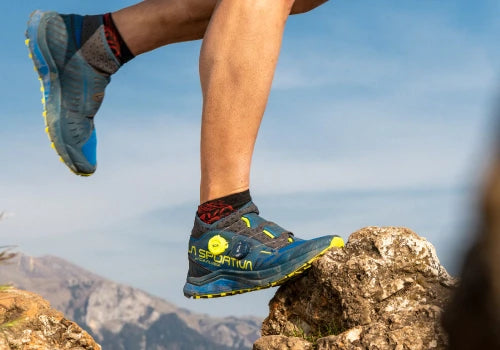
Conquering Australian Trails: Your Guide to Choosing Trail Running Shoes
Embarking on the journey to find the perfect pair of trail running shoes can often feel like tackling an uphill trail itself.
Fret not; this guide is designed to traverse you through the terrain effortlessly.
In case you have urgency, here is what you will read in this article.
Table of Contents:
In case you have urgency, here is what you will read in this article.
Table of Contents:
Are Trail Runners Worth it?
You might wonder, 'Why all the hoopla over trail running shoes? Can't my trusty road runners do the trick?' The answer is probably not.
We'll explain why trail runners are indeed worth the investment and walk you through the essential features to consider.
We'll also delve into how different terrains might influence your choice and even give specific shoe recommendations to handle the varied Australian trails.
Factors to Consider
Cushioning or 'stack height'
How does cushioning shape your trail running shoe choice? It's all about balancing comfort and ground feedback - a delicate "feel vs float" spectrum.
Cushioning, also known as 'stack height,' is the layer of material that separates your foot from the trail. High-cushioning shoes offer plush comfort, reducing fatigue and providing extra support, which is particularly beneficial for longer runs or runners with foot or knee issues.
But hold on. Before sinking into that comfort, bear in mind: every benefit has its cost.
High-cushioning may soften your step, but it also dampens the push-off stage of your stride, potentially making runs feel less dynamic and more laborious. This extra padding also raises your centre of gravity and risks more ankle rolls. Moreover, these shoes tend to be heavier, which isn't ideal for short, speedy runs where lightness is key.
Heel-to-Toe Drop

Heel-to-Toe Drop
Ever puzzled over the term "drop" in trail-running conversations or reviews?
It refers to the height difference between your heel and forefoot in a shoe in millimetres. In simple terms, a high drop (6-12mm) encourages heel-first landing, while a low drop (0-6mm) favours mid- to forefoot impact.
Matching the drop to your natural stride is vital.
Though mid to forefoot landing aligns with our natural running style and is more efficient, fatigue and habit make the majority of us heel-first runners and hence, a high drop suits most, particularly beginners.
Consider a lower drop if you're in the market for a shoe that supports your foot's natural motion and activates the supporting muscles. It encourages shorter strides, which suits the varied pace of trail running compared to road running. But be cautious: transitioning to a low drop should be slow and steady to prevent injuries!
Tread Pattern: A Grip on Trail Shoes
Choosing the right tread is like picking the ideal off-road tires.
The right tread pattern— the size, shape, and positioning of lugs on the outsole— is vital for the best grip and stability.
On hard surfaces like gravel or dirt roads, you need smaller, shallower lugs or 'micro-treads'. These provide a larger contact area and increase friction to keep you stable, as these grounds don't easily deform under pressure.
On the flip side, soft, muddy, or loose terrains require large, deep lugs or 'macro-treads'. These terrains give way easily, so larger lugs penetrate the surface, anchoring you into the ground, not just surface friction. Plus, wider lug spacing helps shed mud and prevents clog-ups.

Outsole Material
The outsole material significantly impacts your trail running shoes' performance. While all trail shoes aim for excellent grip, the rubber compound used sets them apart.
Sticky rubber, like that used in La Sportiva's white Friction X range, excels on rocky or wet surfaces, offering unparalleled traction. However, it tends to wear out fast.
On the other hand, harder rubber compounds, while not as grippy, are durable choices for trails dotted with rocks and hard-packed dirt. They resist wear and tear effectively, making them a go-to for longevity.

Foot Protection
When braving the rugged outdoors with pace, especially under Australia's notoriously harsh conditions, your feet need distinct protection.
Trail running shoes, unlike their road-running counterparts, are specifically designed to shield your feet from the demanding impacts of off-road terrain, particularly during the decent or more technical sections.

One of the most basic protection features is a rock plate - a protective shield within the midsole that disperses pressure and shock on uneven ground - a must-have if technical, rough terrains are your regular running spots.
Additionally, a reinforced toe cap acts like a helmet for your toes, offering extra protection against bumps and scrapes on roots or rocks - another essential feature. The upper materials of a trail shoe - akin to a suit of armour for your feet - are typically constructed with durable materials to withstand abrasion and resist tearing, another aspect to keep in mind.
Fit and Stability
If this is your maiden voyage into the world of trail running, finding the perfect fit may be challenging, but it's worth the effort as it will serve as the keystone for your stability on the trail.
You want to find a shoe that complements your foot profile and provides optimal comfort. Thus, understanding your foot's general width and contours can streamline your selection process. La Sportiva offers a handy visual guide showcasing which trail shoe models best cater to varying foot volumes.
But, the tried-and-true method of finding the right fit is by personally trying on different pairs and letting your foot guide your choice.
Remember, the goal is to have a shoe that fits snugly without causing discomfort or feeling restricted. If the shoe fits too loosely, it may compromise stability, increasing the risk of a foot injury such as a twist or sprain. Conversely, if the shoe is too tight, it can lead to discomfort as the foot naturally expands when it gets warm. Thus, the perfect balance between snugness and flexibility is critical.
Australian Terrain-Specific Recommendations
For those new to the exhilarating world of trail running, the wealth of trails scattered across Australia may astound you.
Essentially, any unpaved natural terrain becomes a runner's playground. Australia, with its myriad National and State Parks, offers a treasure trove of trail running opportunities, each one offering a unique adventure that lies at the heart of the sport.

Dirt & Fire Trails
A staple in the Australian trail running scene, dirt and fire trails often offer a serene escape into nature without straying too far. These trails can be found in urban parks and the countryside.
If you're a Brisbane local, the Enoggera Reservoir circuit on the city outskirts or the tracks in Mount Cootha Reserve, like the Powerful Owl Trail and the Mahogany track, are fantastic places to start your journey.

While generally these trails are flat and less technical, usually featuring hard-packed dirt or crushed gravel, don't be fooled by their smooth surfaces! They can throw in surprises like loose soil, pebbles, or roots and can turn muddy or overly loose depending on the weather.
To tackle these trails, choose versatile, lightweight shoes with robust upper materials. Opt for outsoles with mild to moderate lugs for grip on shifting terrain. If you plan to run on these trails frequently, consider shoes with extra cushioning to minimise the impact on your feet.
Bush & Woodland Trails
Nestled within the heart of National Parks or nature reserves, bush trails lure runners with their tantalising variety and weekend adventure promise.
These trails vary greatly, and each presents a unique character, from forest paths and expansive woodlands to the outstanding scrub and heathlands found in areas like Tasmania.
Typically, these tracks offer a complex array of roots, rocks, and inconsistent terrain. Runners may encounter shifting stones, complex root systems, and, sometimes, challenging slopes. Balance and agility become paramount, and as such, shoes with a lower heel-to-toe drop or a wider base can be beneficial to enhance stability.
Depending on the region and the time of year, the condition of these trails can vary greatly, from a dry, dusty pathway to a muddy obstacle course. Hence, shoes with deeper, multidirectional lugs are a smart choice, offering improved traction on a broader range of surfaces.

Muddy & Rainforest Trails
For those fortunate enough to reside near Australia's sparse and unique rainforest trails, a distinctive and challenging running environment awaits. Drenched in stunning scenic beauty, these lush ecosystems offer an engaging encounter with vibrant biodiversity and an opportunity for a captivating immersion into nature.

While the majority of these rainforest trails lie within well-maintained national parks, providing clear, defined tracks, the paths themselves can be narrow and winding and cocooned by a rich tapestry of dense vegetation. These often technical trails feature persistent dampness, thick undergrowth, and a complex network of roots, rocks, and streams.
For a successful rainforest run, opt for sturdy shoes fitted with aggressive outsoles for superior traction. Footwear with deep, multidirectional lugs and a wide sole, such as La Sportiva's Lycan II, excels in these environments.
As a tip for frequent rainforest trail runners, you might find non-waterproof shoes a more fitting choice. These typically offer better breathability, essential for comfort in high-humidity environments, and dry out faster if they do get wet. Coupling these with the right socks, ones that efficiently wick moisture away, can further enhance your rainforest running experience.
Rocky & Mountainous Trails
While not as widely accessible as other terrains, Australia is home to several notable mountain trail destinations near major cities. You'll find the likes of the Blue Mountains near Sydney, the Dandenong Ranges close to Melbourne, or the Glass House Mountains a stone's throw from Brisbane.
In contrast to flatter terrains, mountain trails often boast a mix of steep inclines, sharp descents, and a rocky, uneven surface. Here, more than any other terrain, you will find technical trails demanding agility, balance and pinpoint foot placement.
The choice of outsole material becomes paramount in this setting. A sticky rubber outsole isn't merely a performance enhancer; it's an essential safety feature. By offering unrivalled grip, it prevents an invigorating mountain trail run from morphing into an unexpected climbing expedition.

Moreover, consider opting for shoes with moderate to low cushioning. This will not only lower your centre of gravity but also amplify your 'feel' of the trail beneath, giving you a better sense of the terrain and enhancing stability. But again, remember to choose a drop that matches your running style.
Final Thoughts
As you lace up to master the diverse terrains of Australia's trails, remember that the choice of your trail running shoe extends beyond mere comfort and style.
It's a decision about ensuring safety, promoting balance, and ultimately, amplifying your trail running experience. Like the way you shape your running path, your shoe selection should be customised to match your adventure. So, take the time to choose wisely and let your footwear empower your journey.
If you'd like personalised advice on selecting the right trail running shoes and would like to get professionally fitted, come and visit us at K2 Basecamp. We can't wait to meet you!
QUICK SUMMARY
Cushioning
A balance between comfort and ground feedback. High-cushioning for increased comfort, suitable for high-mileage runs, and foot or knee problems. Moderate cushioning for technical trails requiring agility and precise foot placement.
Heel-to-Drop
Higher drop (6-12mm) for heel-first runners, common among beginners and most runners. Lower drop (0-6mm) to support natural foot motion, activates supporting muscles, and suits varied paces of trail running.
Tread Pattern
Small, shallow lugs ('micro-treads') for firmer surfaces like gravel and dirt roads. Deep, large lugs ('macro-treads') for soft, muddy, or loose terrains.
Outsole Material
Sticky rubber for excellent traction on rocky or wet surfaces but tends to wear out fast. Harder rubber compounds for durability on trails with rocks and hard-packed dirt.
Foot Protection
Features like a rock plate for underfoot protection, reinforced toe cap for frontal protection, and heel counter for stability are essential, especially on rocky and rough terrains.
Fit and Stability
The width and size of the shoe should complement your physical build and offer optimum comfort. Take time to try different pairs before making a final decision.
QUICK SUMMARY
Cushioning
A balance between comfort and ground feedback. High-cushioning for increased comfort, suitable for high-mileage runs, and foot or knee problems. Moderate cushioning for technical trails requiring agility and precise foot placement.
Heel-to-Drop
Higher drop (6-12mm) for heel-first runners, common among beginners and most runners. Lower drop (0-6mm) to support natural foot motion, activates supporting muscles, and suits varied paces of trail running.
Tread Pattern
Small, shallow lugs ('micro-treads') for firmer surfaces like gravel and dirt roads. Deep, large lugs ('macro-treads') for soft, muddy, or loose terrains.
Outsole Material
Sticky rubber for excellent traction on rocky or wet surfaces but tends to wear out fast. Harder rubber compounds for durability on trails with rocks and hard-packed dirt.
Foot Protection
Features like a rock plate for underfoot protection, reinforced toe cap for frontal protection, and heel counter for stability are essential, especially on rocky and rough terrains.
Fit and Stability
The width and size of the shoe should complement your physical build and offer optimum comfort. Take time to try different pairs before making a final decision.


